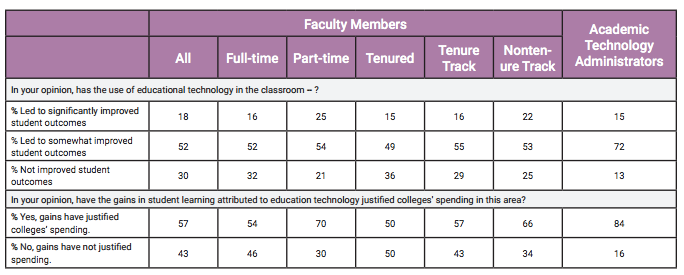You have /5 articles left.
Sign up for a free account or log in.
There is one number that everyone who works in educational technology should internalize -- 43 percent.
This percentage comes from the 2016 Inside Higher Ed Survey of Faculty Attitudes on Technology. Faculty members were asked: “In your opinion, have the gains in student learning attributed to educational technology justified colleges’ spending in this area?”
A total of 43 percent who answered said “no, gains have not justified spending.” The results are worse when examined by rank -- 50 percent of tenured faculty members said they believe that the level of campus technology spending is a bad bargain when compared with gains in student learning.
Likewise, the corresponding percentage for academic technology administrators who answered the questions was 16 percent.

Everything that those of us who work in edtech -- including both campus and company employees -- do should be informed by these findings. The disturbing truth is that almost half of all faculty don’t believe that our work in edtech is a net positive on their campuses.
Trust is Key
In an environment where many members of the academic community have the power of veto, and where decision making is diffused and distributed (otherwise known as shared governance), developing widespread trust is essential for any change effort. This survey shows that introducing any sustained campus-wide technology-enabled initiative, particularly one that carries risk, will be very difficult in a low-trust environment.
Those of us in edtech should take these data as indications that we have failed to demonstrate empathy for the faculty in which we ostensibly serve. What these numbers tell me is that a near majority of faculty do not believe that the people who work in educational technology -- either within campuses or for edtech companies -- understand or fully appreciate their perspectives or concerns.
Further, I doubt that any amount of arguments will persuade many faculty on the merits of investing in edtech. My colleague Brendan Nyhan, who coined the term "backfire effect," has demonstrated in his research that "corrections actually increase misperceptions among the group in question.”
Those of us in edtech, including the staff of marketing departments at edtech companies, need to stop pushing “success stories” on skeptical faculty. Rather, we should do what Michael Shermer, writing for the January 2017 issue of Scientific American, suggests:
a. Listen carefully, and then be able to accurately articulate the position of skeptical faculty.
b. Show respect for the faculty who have little faith or belief in edtech, and who believe that spending on campus technology is not justified by results.
c. Acknowledge that we understand why faculty may hold negative edtech beliefs.
To close the faculty trust gap, edtech people need to spend much more time listening. This requires that we are present in the places where professors talk to one another as well as the persistent to stay in that conversation.
We need to figure out how we in edtech can move from transactional to reciprocal relationships with faculty. Rather than convince professors that they should support institutional investments (or risk taking) with technology, we should seek to understand their goals and constraints.
Most important, building trust between the edtech and faculty worlds should be our No. 1 goal..
But this requires collaboration among academic and corporate technology leaders. We need to understand that academic and industry educational technologists face a common set of challenges.
We are in this together.





